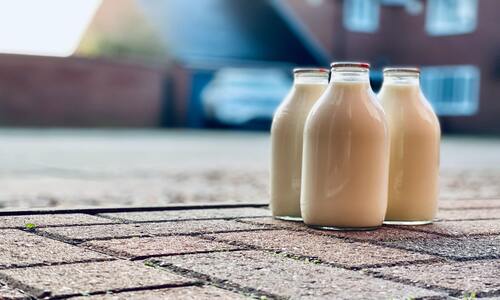Dairy products are prone to bacteria and mold growth, with milk being no exception. It’s incredibly frustrating to go to your refrigerator to take out the milk, only to find that it has gone off and become moldy. So, is the milk still safe to drink, or do you need to throw it away?
Fungal spores present naturally within the air can contaminate even pasteurized milk. Once the milk carton or container has been opened, additional spores can settle within the liquid and begin to spread If not refrigerated properly or if it has gone past its use-by date.
In this article, we will cover all these questions and more, so, for all you need to know about mold on milk, keep reading!

Related articles
Mold In Yogurt: Is It Safe To Eat And How To Prevent It
Moldy Butter: Is It Safe To Use And Can It Be Saved?
Mold On Sour Cream: Safe To Eat? And How To Tell If It Is Bad
Mold On Ice Cream: Safe To Eat? And How To Tell If It’s Bad
Can milk grow mold?
Mold can indeed grow in liquid milk, as spores and bacteria present within the air in the tanks the milk is stored in can continue to live within the liquid. The rate at which this mold grows slows down as the milk is refrigerated and packaged.
Visible mold is more likely to grow on milk that has begun to spoil, and you will be able to identify this by changes in its texture, smell, and taste. Spoiled milk will have a lumpy texture, and begin to have a slight smell of sourness to it. Only after this point is it likely that you could begin to see mold forming.
will have a lumpy texture, and begin to have a slight smell of sourness to it. Only after this point is it likely that you could begin to see mold forming.
Mold can and will grow anywhere if the circumstances are correct for it, all it needs is moisture, a source of nutrients, and an optimal temperature range.
are correct for it, all it needs is moisture, a source of nutrients, and an optimal temperature range.
Milk has a high water content and provides all the nutrients mold needs to survive. Storing milk incorrectly and at too high of a temperature can also create the ideal circumstances for rapid mold growth. The mold that is sometimes found living within liquid milk rarely grows at any noticeable rate as long as it is stored below 40 degrees Fahrenheit.
Fahrenheit.
What kinds of mold grow on milk?
The most common strains of mold found growing on milk and milk-based products are Penicillium, Aspergillus , and Mucor genera
, and Mucor genera .
.
Penicillium is found growing in not only milk but butter and yogurt products. And is frequently found growing on decaying vegetation, within soil, and on fresh fruit and vegetables.
Mucor genera is a rapidly growing strain commonly seen growing in soil, digestive systems, plants, and rotten vegetable matter.
Aspergillus is a very common mold, found growing in soil, on decaying vegetation, and grains. Pasteurization of milk will kill the majority of mold and bacteria, however, there is a risk of airborne molds finding their way into the milk during the bottling and packaging stages due to cross-contamination.
While these may be the most commonly seen strains, this list is by no means exhaustive, and several other strains have the potential to grow in milk and other dairy products, one of these strains includes the Cladosporium genus, as it can be found growing successfully in various environments.
genus, as it can be found growing successfully in various environments.
What does moldy milk look like?
Mold on milk and dairy products will often grow in blue-green circular patches and will have a powdery texture. If you spot the mold growing early enough, it may have a white appearance that turns more blue over time.
Should Mucor mold have developed, the growth would initially appear white and have a fluffy texture, with this turning more yellow over time.
Milk would have usually spoiled before becoming moldy, so it will also have begun to thicken and become lumpy, with splits and cracks on its surface. It may also have a sour smell and taste while the container it is in may have begun to expand, which indicates gas production from bacterial growth.
For an excellent visual representation of what mold growing on milk looks like, take a look at this time lapse video of it happening.
Is mold on milk dangerous?
The strains of mold found growing in milk do have the ability to cause stomach upset and allergic reactions in those sensitive to them. However, the amount of mold that you would be ingesting or inhaling would (in most cases), be very little. This makes the chances of any serious harm coming from drinking mold in milk quite unlikely unless you are highly allergic.
or inhaling would (in most cases), be very little. This makes the chances of any serious harm coming from drinking mold in milk quite unlikely unless you are highly allergic.
While some of the strains found growing in milk can produce harmful mycotoxins, they are usually created and released later within their growth cycle, meaning the milk would usually be highly spoiled before significant numbers of mycotoxins had been released.
What to do if you accidentally drink moldy milk?
Should you accidentally eat or drink mold growing in a container of milk, you would only need to seek medical advice if you had an allergic reaction or medical symptoms, if no symptoms were present, you should monitor yourself over the next few days for any new symptoms you think could be associated with consuming the moldy milk.
Some of the more common symptoms to look out for if you have allergies to mold can include.
- Sneezing
- Runny or Stuffy Nose
- Itchy or Watery Eyes
- Itchy Throat
- Coughing
- Shortness of Breath
Can you remove the moldy bits and drink the rest?
No, if you find mold growing on top of the milk in a carton or bottle, or even on the side of the carton, the milk is not fit for consumption and it should be thrown away. Even if you were to remove the patches of mold, there is a good chance that its spores could have been released into the milk, or mycotoxins may also already be present within the liquid.
may also already be present within the liquid.
Not all mold growth is visible to the naked eye, so simply removing what you can see growing does not mean you have successfully removed all fungal growth, and microscopic growth could still be present.
Can milk get moldy in the fridge?
Absolutely, while mold grows at its most rapid rate in temperature ranges between 77° Fahrenheit and 91.4° Fahrenheit , some strains can grow perfectly well (albeit at a slower rate) in temepratures as low as 32° Fahrenheit.
, some strains can grow perfectly well (albeit at a slower rate) in temepratures as low as 32° Fahrenheit.
While storing milk at lower temepratures certainly helps to slow the rate of growth in fungi and bacteria, it will not stop it completely, and so special attention should be paid to the products use-by date, as spoilage (and therefore fungal growth) are more likely to occur.
Does spoiled milk have mold?
Fungi and mold are more likely to be found growing in spoiled milk, however, just becuase milk has spoiled does not guarentee fungal growth. Bacteria may be present within the milk which has spoiled it, but fungal spores may not have settled within the liquid or its container if it had not been opened after being pasturized, therefore making growth highly unlikely.
How to prevent milk from growing mold
The best way to prevent mold growth on milk and milk-based products is to make sure you are storing them correctly.
Milk products should be kept refrigerated below 40 degrees Fahrenheit , and if possible towards the back of the fridge where there is less temperature change.
, and if possible towards the back of the fridge where there is less temperature change.
Milk cartons are often kept on the shelves located at the door of the fridge, but this exposes them to frequent changes in temperature, which can allow the milk to spoil at a faster rate. So, if possible, keep the milk towards the back of the fridge and nearer the bottom shelves where the temperature is more consistent.
Also, pay close attention to the “use-by” date on the milk container, if you don’t think you will be able to use the product before the date stated, consider buying a smaller carton or looking for one with a longer shelf-life. Once you go past the date specified, spoilage and mold formation will begin.
FAQ
Can you still use moldy milk?
No, milk that has spoiled to the point where mold can begin to grow cannot be saved or utilized in any way. Once the milk is spoiled, the taste and texture will break down to the point where it becomes very unpleasant, so it should be discarded as soon as this is noticed.
How long does it take for milk to go moldy?
Under the correct circumstances, milk can begin to spoil and grow mold in only a few hours. As soon as the temperature of the milk goes beyond 40 degrees Fahrenheit, signs of spoilage can be seen. After a day or two, visible signs of mold growth such as patches of white, green, or blue mold will become apparent.
What is the pink mold that grows in milk?
The pink mold that is sometimes seen growing in milk and other dairy products is not mold but is a bacteria known as Serratia marcescens .
.
This strain can be found growing in any moist conditions, and so favors soil and water, but can also be found on dairy products and vegetable produce.
The bacteria can cause several unpleasant symptoms if ingested, so should any signs of growth be noticed, the product it was found growing on should be thrown away.
What is the orange fungus in milk?
Many strains of mold can become orange in color, but the most commonly found growing on dairy products is Aleuria Aurantia .
.
This strain has an orange color, but its most noticeable characteristic is its texture which resembles an orange peel.
This strain has been said to be less dangerous than others with a similar color, however, bacteria are commonly seen growing alongside Aleuria Aurantia which can cause health complaints, so if it is noticed, the product should certainly be discarded.
Conclusion
Milk like other dairy products can indeed grow mold, but this usually occurs after the milk has already spoiled. The most common strains of mold found growing on milk and dairy products are penicillium and Mucor genera. These strains can cause stomach upset and allergic reactions in those sensitive to them, so any products found with mold growing on them should be discarded.
Over to you
I hope this article has helped you understand a little more about why milk gets moldy and what to do if you’ve accidentally drunk some. Now I’d like to turn things over to you. Have you ever drank moldy milk? Do you have any methods to keep your milk fresher for longer, or do you have any questions about anything I’ve written here? If so, please leave a comment below and I’ll get right back to you.

